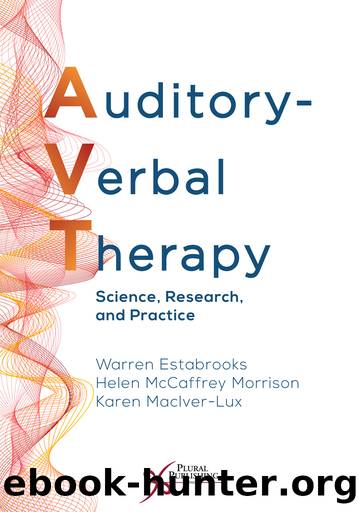Auditory-Verbal Therapy: Science, Research, and Practice by Warren Estabrooks;Helen McCaffrey Morrison;Karen MacIver-Lux;

Author:Warren Estabrooks;Helen McCaffrey Morrison;Karen MacIver-Lux; [Estabrooks, Warren]
Language: eng
Format: epub
Publisher: Plural Publishing Inc.
Published: 2020-08-15T21:00:00+00:00
Phonological and Phonemic Awareness and Knowledge
During the past two decades, research has pointed to a connection between insufficient phonological skill, specifically phonemic awareness, and an increased risk of reading difficulties in children with typical hearing (Catts, Fey, Zhang, & Tomblin, 2001; Schuele & Boudreu, 2008; Yopp, 1997), and this knowledge has obvious implications for children who are deaf or hard of hearing. In the United States, The National Reading Panel (Eunice Kennedy Shriver National Institute of Child Health and Human Development, NIH, DHHS, 2000) identified phonemic awareness as a key building block in reading acquisition. Children with phonological awareness sensitivity recognize the sound structure of a spoken language and can manipulate this sound structure of spoken words at the syllable, onset-rime, and phoneme levels (Gillon, 2004). Phonological awareness sensitivity enables the child to make the connection between the letter (the graphemic symbol) and the letter sound (the phonemic vocalization), thus supporting skills in word decoding that help the child connect written symbols with spoken language that is stored in memory. An awareness of the phoneme as it relates to the spoken sound structure supports reading acquisition and is necessary to discovering the logic of the written system (Yopp, 1999). Such awareness must precede phonics instruction; otherwise the instruction does not make sense to the emerging reader. The development of alphabetic awareness begins with the childâs discovery of one written letter and its sound, and proceeds to working out the multiple relationships between sounds and their written symbols (Adams, 2002). This is the goal of many of the alphabet books created for very young children. Linking visible letters to audible sounds is not, however, the entire story because many words in English do not follow general pronunciation rules (âhaveâ and âcaveâ do not rhyme), and children must learn that rules are often just guidelines that offer approximations.
Phonological awareness and phonemic awareness require full auditory access to the entire speech spectrum. In the past, as described above, this requisite skill underlying literacy development posed major obstacles for children who are deaf or hard of hearing due to poor auditory accessibility to all the sounds of speech. The current combination of early identification, state-of-the-art hearing technologies, and early Auditory-Verbal Therapy intervention can ameliorate the debilitating factors that hearing loss poses, thereby opening the door to age-appropriate listening, talking, reading, writing, and thinking skills that define literacy achievement.
Mastery of Language Structure
For the child with hearing loss, the absence or instability of phonological knowledge is highly problematic, because so much is conveyed by the sounds in phonemes (the smallest units of speech), syllables, words, phrases, sentences, and longer utterances represented as paragraphs and chapters. For the beginning reader, a growing ability to listen and then segment a phrase into words, a word into syllables, and a syllable into phonemes is needed in order to begin to make sense of how words are put together. As the child hears, listens, and uses more spoken language, she or he becomes better prepared to identify words and word parts in print.
Download
This site does not store any files on its server. We only index and link to content provided by other sites. Please contact the content providers to delete copyright contents if any and email us, we'll remove relevant links or contents immediately.
| Administration & Medicine Economics | Allied Health Professions |
| Basic Sciences | Dentistry |
| History | Medical Informatics |
| Medicine | Nursing |
| Pharmacology | Psychology |
| Research | Veterinary Medicine |
Dynamic Alignment Through Imagery by Eric Franklin(3489)
Body Love by Kelly LeVeque(2630)
Barron's AP Calculus by David Bock(1449)
EMT Exam For Dummies with Online Practice by Arthur Hsieh(1442)
The Juice Lady's Remedies for Asthma and Allergies by Cherie Calbom(1347)
Fitness Walking For Dummies by Liz Neporent(1288)
Extremes: Life, Death and the Limits of the Human Body by Fong Kevin(1199)
McGraw-Hill Nurses Drug Handbook by Patricia Schull(1185)
Flight by Elephant(1152)
The Natural First Aid Handbook by Brigitte Mars(1115)
Tell by Major Margaret Witt(1100)
Born to Walk by James Earls(1075)
Seeing Voices by Oliver Sacks(1073)
Skin by Unknown(1059)
Cracking the Nursing Interview by Jim Keogh(1025)
First Aid for Colleges and Universities (10th Edition) by Mistovich Joseph J. & Limmer Daniel J. & Karren Keith J. & Hafen Brent Q(1019)
The Yoga Bible by Christina Brown(927)
Living Ready Pocket Manual - First Aid: Fundamentals for Survival by James Hubbard(925)
Social Linguistics and Literacies by Gee James;(920)
